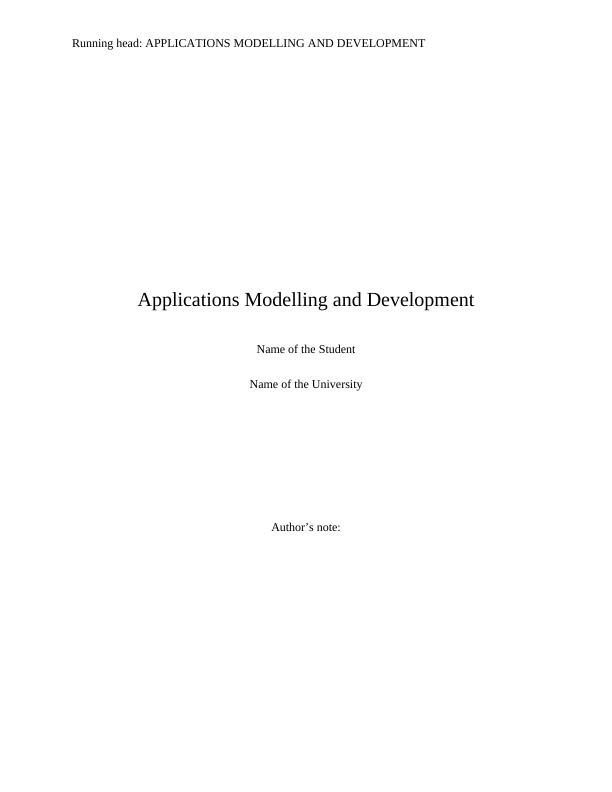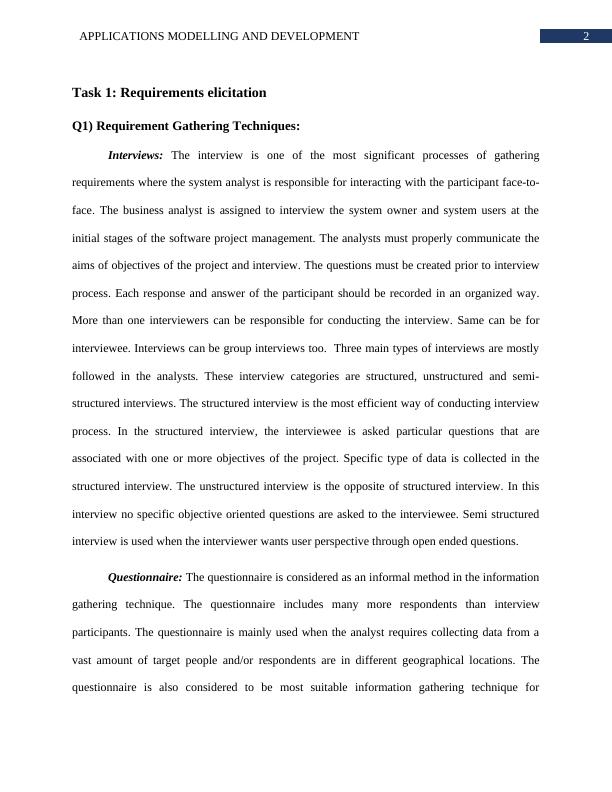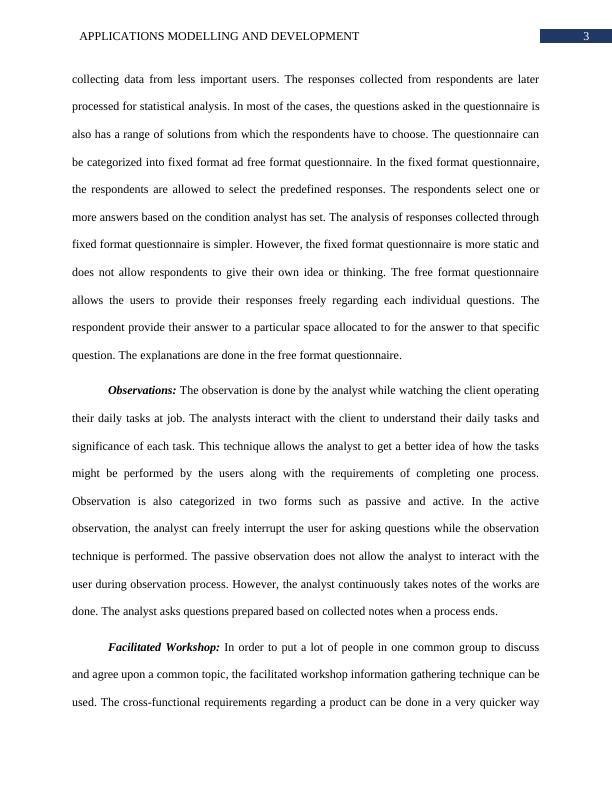Applications Modelling and Development
Added on 2023-01-18
20 Pages3228 Words58 Views
Running head: APPLICATIONS MODELLING AND DEVELOPMENT
Applications Modelling and Development
Name of the Student
Name of the University
Author’s note:
Applications Modelling and Development
Name of the Student
Name of the University
Author’s note:

1APPLICATIONS MODELLING AND DEVELOPMENT
Table of Contents
Task 1: Requirements elicitation.....................................................................................................2
Q1) Requirement Gathering Techniques:....................................................................................2
Q2) Strategy of Information Gathering:......................................................................................5
Task 2: Requirements specification.................................................................................................5
Q3) User Scenarios:.....................................................................................................................5
Q4) User Stories:.........................................................................................................................6
Q5) Functional Requirements:.....................................................................................................6
Q6) Non-Functional Requirements:............................................................................................7
Task 3: Diagrams for different system perspectives........................................................................9
Q7. Context Diagram:..................................................................................................................9
Q8. Use Case Diagram:.............................................................................................................10
Q9. Use Case Description:.........................................................................................................11
Q10. Sequence Diagram:...........................................................................................................12
Q11.Entity Class Diagram:........................................................................................................13
Q12. State Diagram:..................................................................................................................14
Task 4: Data and storage considerations.......................................................................................15
Q13. ER Diagram:.....................................................................................................................15
Q14. List of Tables:...................................................................................................................15
Bibliography:.................................................................................................................................18
Table of Contents
Task 1: Requirements elicitation.....................................................................................................2
Q1) Requirement Gathering Techniques:....................................................................................2
Q2) Strategy of Information Gathering:......................................................................................5
Task 2: Requirements specification.................................................................................................5
Q3) User Scenarios:.....................................................................................................................5
Q4) User Stories:.........................................................................................................................6
Q5) Functional Requirements:.....................................................................................................6
Q6) Non-Functional Requirements:............................................................................................7
Task 3: Diagrams for different system perspectives........................................................................9
Q7. Context Diagram:..................................................................................................................9
Q8. Use Case Diagram:.............................................................................................................10
Q9. Use Case Description:.........................................................................................................11
Q10. Sequence Diagram:...........................................................................................................12
Q11.Entity Class Diagram:........................................................................................................13
Q12. State Diagram:..................................................................................................................14
Task 4: Data and storage considerations.......................................................................................15
Q13. ER Diagram:.....................................................................................................................15
Q14. List of Tables:...................................................................................................................15
Bibliography:.................................................................................................................................18

2APPLICATIONS MODELLING AND DEVELOPMENT
Task 1: Requirements elicitation
Q1) Requirement Gathering Techniques:
Interviews: The interview is one of the most significant processes of gathering
requirements where the system analyst is responsible for interacting with the participant face-to-
face. The business analyst is assigned to interview the system owner and system users at the
initial stages of the software project management. The analysts must properly communicate the
aims of objectives of the project and interview. The questions must be created prior to interview
process. Each response and answer of the participant should be recorded in an organized way.
More than one interviewers can be responsible for conducting the interview. Same can be for
interviewee. Interviews can be group interviews too. Three main types of interviews are mostly
followed in the analysts. These interview categories are structured, unstructured and semi-
structured interviews. The structured interview is the most efficient way of conducting interview
process. In the structured interview, the interviewee is asked particular questions that are
associated with one or more objectives of the project. Specific type of data is collected in the
structured interview. The unstructured interview is the opposite of structured interview. In this
interview no specific objective oriented questions are asked to the interviewee. Semi structured
interview is used when the interviewer wants user perspective through open ended questions.
Questionnaire: The questionnaire is considered as an informal method in the information
gathering technique. The questionnaire includes many more respondents than interview
participants. The questionnaire is mainly used when the analyst requires collecting data from a
vast amount of target people and/or respondents are in different geographical locations. The
questionnaire is also considered to be most suitable information gathering technique for
Task 1: Requirements elicitation
Q1) Requirement Gathering Techniques:
Interviews: The interview is one of the most significant processes of gathering
requirements where the system analyst is responsible for interacting with the participant face-to-
face. The business analyst is assigned to interview the system owner and system users at the
initial stages of the software project management. The analysts must properly communicate the
aims of objectives of the project and interview. The questions must be created prior to interview
process. Each response and answer of the participant should be recorded in an organized way.
More than one interviewers can be responsible for conducting the interview. Same can be for
interviewee. Interviews can be group interviews too. Three main types of interviews are mostly
followed in the analysts. These interview categories are structured, unstructured and semi-
structured interviews. The structured interview is the most efficient way of conducting interview
process. In the structured interview, the interviewee is asked particular questions that are
associated with one or more objectives of the project. Specific type of data is collected in the
structured interview. The unstructured interview is the opposite of structured interview. In this
interview no specific objective oriented questions are asked to the interviewee. Semi structured
interview is used when the interviewer wants user perspective through open ended questions.
Questionnaire: The questionnaire is considered as an informal method in the information
gathering technique. The questionnaire includes many more respondents than interview
participants. The questionnaire is mainly used when the analyst requires collecting data from a
vast amount of target people and/or respondents are in different geographical locations. The
questionnaire is also considered to be most suitable information gathering technique for

3APPLICATIONS MODELLING AND DEVELOPMENT
collecting data from less important users. The responses collected from respondents are later
processed for statistical analysis. In most of the cases, the questions asked in the questionnaire is
also has a range of solutions from which the respondents have to choose. The questionnaire can
be categorized into fixed format ad free format questionnaire. In the fixed format questionnaire,
the respondents are allowed to select the predefined responses. The respondents select one or
more answers based on the condition analyst has set. The analysis of responses collected through
fixed format questionnaire is simpler. However, the fixed format questionnaire is more static and
does not allow respondents to give their own idea or thinking. The free format questionnaire
allows the users to provide their responses freely regarding each individual questions. The
respondent provide their answer to a particular space allocated to for the answer to that specific
question. The explanations are done in the free format questionnaire.
Observations: The observation is done by the analyst while watching the client operating
their daily tasks at job. The analysts interact with the client to understand their daily tasks and
significance of each task. This technique allows the analyst to get a better idea of how the tasks
might be performed by the users along with the requirements of completing one process.
Observation is also categorized in two forms such as passive and active. In the active
observation, the analyst can freely interrupt the user for asking questions while the observation
technique is performed. The passive observation does not allow the analyst to interact with the
user during observation process. However, the analyst continuously takes notes of the works are
done. The analyst asks questions prepared based on collected notes when a process ends.
Facilitated Workshop: In order to put a lot of people in one common group to discuss
and agree upon a common topic, the facilitated workshop information gathering technique can be
used. The cross-functional requirements regarding a product can be done in a very quicker way
collecting data from less important users. The responses collected from respondents are later
processed for statistical analysis. In most of the cases, the questions asked in the questionnaire is
also has a range of solutions from which the respondents have to choose. The questionnaire can
be categorized into fixed format ad free format questionnaire. In the fixed format questionnaire,
the respondents are allowed to select the predefined responses. The respondents select one or
more answers based on the condition analyst has set. The analysis of responses collected through
fixed format questionnaire is simpler. However, the fixed format questionnaire is more static and
does not allow respondents to give their own idea or thinking. The free format questionnaire
allows the users to provide their responses freely regarding each individual questions. The
respondent provide their answer to a particular space allocated to for the answer to that specific
question. The explanations are done in the free format questionnaire.
Observations: The observation is done by the analyst while watching the client operating
their daily tasks at job. The analysts interact with the client to understand their daily tasks and
significance of each task. This technique allows the analyst to get a better idea of how the tasks
might be performed by the users along with the requirements of completing one process.
Observation is also categorized in two forms such as passive and active. In the active
observation, the analyst can freely interrupt the user for asking questions while the observation
technique is performed. The passive observation does not allow the analyst to interact with the
user during observation process. However, the analyst continuously takes notes of the works are
done. The analyst asks questions prepared based on collected notes when a process ends.
Facilitated Workshop: In order to put a lot of people in one common group to discuss
and agree upon a common topic, the facilitated workshop information gathering technique can be
used. The cross-functional requirements regarding a product can be done in a very quicker way

End of preview
Want to access all the pages? Upload your documents or become a member.
Related Documents
Requirements Elicitation and UML Modelling for Macquarie University Dating System (MUDS)lg...
|12
|2212
|143
System Analysis and Designlg...
|10
|1229
|80
Requirements Gathering Techniques and Stageslg...
|12
|1455
|76
System Analysis and Design: Techniques for Information Gathering and Process Analysislg...
|9
|1353
|390
Introduction to Systems Design: A Case Study of Scene Brokerslg...
|13
|2133
|337
System Analysis and Designlg...
|11
|1617
|281
